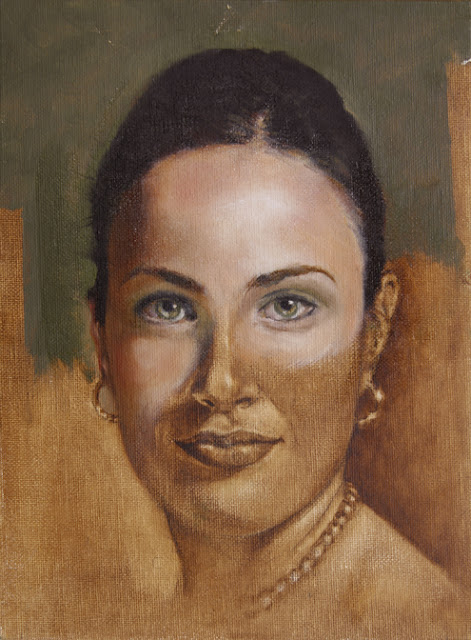This is the fourth in a series I'm doing with my oil painting class on Tuesday mornings. If you are just now joining in check out:
Part 1, which dealt with griding, drawing and the rub out under painting stage;
Part 2, which included premixing a flesh tone palette and storage of paint;
Part 3, in which I explored oiling out, and the pros and cons of working from photographs.
I worked on this about 45 minutes in class, then continued working on it another 2 hours after I got home.
A few surprises and discoveries happened this session.
Discovery # 1:
Last week I had worked on the forehead and one eye in class. Normally I work on both eyes simultaneously, but in the interest of not demoing too long that's how it worked out.
Turns out -- not a good idea, it's far too easy to get them looking googley. (official art term). Initially, after my 45 minutes painting in class, I had one too low and one too high, slightly, but in a face that is a significant error. Without time constraints I try to do the initial pass on the face in one day.
Discovery # 2:
I'm constantly trying to figure out better ways to teach what it is that I do. During class last week I noticed a common error. I found myself saying repeatedly, "Your shadows aren't dark enough" as I went easel to easel. It must be something I wasn't getting across. The search for a solution led me to a slightly revised palette.
I initially mix up the most chromatic mid-tones that you see circled here, then add white to each color string to create at least 4 values (follow the down arrow).
My method up to now has been to just have a big pile of darks in the lower right of my palette that I will mix these mid-tones with for my darkest flesh areas.
After seeing my students struggle a little bit with this I decided that the colors strings should continue on to include the darks (follow the up arrow).
After seeing this I'm surprised it hasn't occurred to me sooner, it seems so obvious. I was doing the mixing of the dark colors more by instinct than by method. This is going to work so much better, for me and for my students!
The important thing is to mix from the mid-tones to the dark and the mid-tones to the light. The mid-tones do not include white.
Once white is in a color pile I do not use it to make a dark, I consider it contaminated. If I want a darker color I go back to the original, unpolluted color, which I think of as pure color.
This is the best way I've found to keep flesh tones from being chalky and to have nice clear transparent shadows.
Discovery #3:
Apparently keeping your painting in a plastic tub with a lid will slow down drying time, who knew? This was yet another obvious thing I hadn't thought about before in terms of painting.
When
I oiled out the part of the painting I'd done the week before, it was
still wet and the forehead smeared. I looked at my class and said, "What
the bleep?" After a week it most definitely should have been dry.
After a little discussion, we decided that it was the Rubbermaid container, a homemade wet canvas carrier, that I carry paintings back forth to class in. I had not taken the painting out during the week. Mystery solved.
I'm learning so much from my students and am grateful to them every week for helping me make these discoveries!
I've written before about the necessity of mistakes in the learning process. Maybe it helps to think of them as discoveries. Relish them and recognize them as the stepping stones they are.
They will get you where you want to be and if you're like me it's simply better. Not much of a finite destination but one heck of a journey!
I invite you to checkout the catalog for The Expedition and Beyond, a group show I'm in next month at Principle Gallery in Alexandria, VA. Enjoy.

58 pages, published 1 MAR 2012
The Expedition and Beyond- Work by 13 artists, introduced through the Women Painting Women phenomenon of 2010, who continue to be challenged and inspired by each other. They come together once again in a show at Principle Gallery, Alexandria, Va, April 2012. Foreword by John O'Hern, American Art Collector, Santa Fe editor.



















